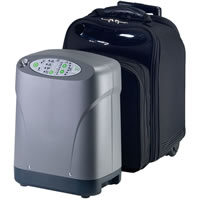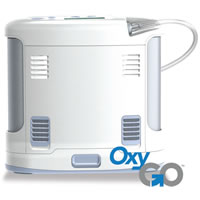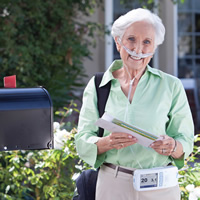Portable Oxygen Marketplace
Portable Oxygen Solutions
As portability demonstrates both a business and a therapeutic upside, the range of product options is getting broader -- and more interesting.
- By Joseph Duffy
- Oct 01, 2015
Over the last few years, portable oxygen has received much attention. Much of that stems from HME respiratory providers looking for ways to create new revenue streams and save time and money by becoming more efficient. When recently asked about top revenue opportunities that exist for respiratory providers in the coming year, Dave Marquard, Owner and CEO of OxyGo, LLC, and Applied Home Healthcare Equipment, LLC, pointed at portable oxygen concentrators (POCs).
“Portable oxygen concentrators are only 5 percent of Medicare oxygen billings and it is estimated that 60 percent of patients will benefit from ambulatory oxygen,” he said. “POCs will likely continue to grow and replace conventional methods, such as cylinders. More providers will see the benefits of replacing cylinders with POCs.” He also predicted that POCs will be the fastest growing category of respiratory products from a cost reduction and patient satisfaction point of view.
The 2013 Medicare HCPCS claims data for POCs (E1392) are $29.4 million (vs. $22.8 in 2012) in allowed claims, which represent an estimated 50,292 patients. For HomeFill, that number is $31 million (vs. $32.5 in 2012), representing an estimated 53,258 patients. It appears POC use has caught up to HomeFill, at least with Medicare claims. And as Bob Hoffman, Vice President, Nationwide Respiratory, VGM group said, seniors have cash and their families are also more willing now than ever before to spend money on medical accessories.
“The POC market, travel CPAPs and any items to make their in-home care easier and more convenient present opportunities to create cash flow,” he said.
POC manufacturers continue to refine their systems. Over the last 10 years, POCs have become smaller, less expensive, lighter, more reliable, giving mobility back to many oxygen patients. And as there is increasing pressure to improve patient outcomes and reduce re-admittance for ACOs and hospitals, experts say POCs offer a better therapy that helps meet these goals.
Here are some of the latest portable oxygen options on the market:
 iGo Portable Oxygen System
iGo Portable Oxygen System
- Weighing less than 20 pounds, the three-liter concentrator is designed to assist patients in maintaining an
active lifestyle.
- The iGo can operate in continuous flow mode from 1-3 LPM or in settings 1-6 using DeVilbiss PulseDose oxygen delivery technology.
- The iGo has a built-in DeVilbiss oxygen-sensing device to ensure accurate oxygen delivery and a reduced periodic maintenance schedule.
Drive Medical Design & Mfg.
(877) 224-0946
www.drivemedical.com
Booth no. 911
 OxyGo Portable Oxygen Concentrator
OxyGo Portable Oxygen Concentrator
- Clinically validated for 24/7 oxygen use for use at home or away, the POC includes the company’s
Intelligent Delivery Technology along with four pulse flow settings: 1, 2, 3, & 4.
- The device includes AC power supply and DC power supply for mobile use in car, and it is wearable at 4.8 lbs with single battery.
- For usability, the OxyGo has simple control functions and easy-to-read LCD display.
Applied Home Healthcare Equipment LLC
(440) 788-4101
www.oxygo.life
Booth no. 611
 NIOV Portable Ventilator
NIOV Portable Ventilator
- Using a 1-pound ventilator and nasal-pillow style interface, the NIOV system combines with an external source of oxygen to deliver a set volume of oxygen each time the patient inhales.
- System can ventilate patients by delivering total tidal volume of up to 1,150 mL and positive inspiratory pressure of up to 18 cmH2O.
- The NIOV System detects a patient’s spontaneous breathing via sensor ports located in the nasal interface and delivers synchronized volumes of air and oxygen at rates of up to 40 breaths per minute.
Breathe Technologies Inc.
(949) 988-7700
www.breathetechnologies.com
Booth no. 2344
 LifeChoice Activox 4L
LifeChoice Activox 4L
- A 4.8-lb., FAA-approved device that provides up to 4 LPM eq. using Inova’s PULSE-WAVE Delivery, with an oxygen Sensor standard on every unit, and up to 10.25 hours of internal battery runtime.
- Controls include a Transflective display; clear alarm and charging notifications; simplified hour meter and purity readings; tailored compliance tracking.
- Standard accessories include a four-way carry case; adjustable straps; AC power supply; DC power supply; accessory bag; nasal cannula; and an external battery is available.
Inova Labs
(512) 617-1700
www.inovalabs.com
Booth no. 1632
This article originally appeared in the Respiratory Management October 2015 issue of HME Business.
About the Author
Joseph Duffy is a freelance writer and marketing consultant, and a regular contributor to HME Business and DME Pharmacy. He can be reached via e-mail at [email protected].